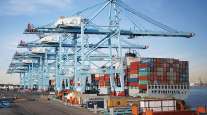Positive Traffic News at Ports of Virginia, Charleston, Jacksonville

November was a positive month for several of the top ports in North America, according to monthly statistics released in mid-December.
The Port of Virginia registered its second-busiest month in history with double-digit year-over-year gains in containerized cargo traffic for the month of November.
Longshoremen handled 236,155 industry-standard 20-foot-equivalent container units, or TEUs, last month, up 16.1% from the 203,472 one year ago. Although 16 fewer vessels called the port in November than the year prior, the number of imported containers rose to 105,585 from 90,224. Exported containers increased to 130,571 from 113,248 in November 2015.
RELATED: Port of Virginia on pace to end 2016 on strong note
Truck traffic through the port, which ranks No. 7 in North America based on containerized cargo volume, rose 8% while rail volume jumped 35%. Volume at the inland port in Northern Virginia went up 3% and barge traffic to the Richmond Marine terminal increased 20%.
“November was a strong month, and we experienced solid growth in import and export volumes, which were up 17 percent and 15 percent (respectively); our peak-season volumes will begin tapering off in December, which is normal,” said John Reinhart, CEO of the Virginia Port Authority. “We were in positive territory in many categories, but one exception is vessel calls, and this is in keeping with the era of fewer calls, but larger vessels and corresponding cargo volumes.”
November marks the 10th consecutive month volumes exceeded 210,000, and through last month, the port handled 2.42 million TEUs. The port should outpace total container traffic for 2015, only 123,190 TEUs short with one more month left.
The Port of Oakland, which ranks No. 9, posted a 2.3% jump in container traffic compared with November 2015, handling 196,981 TEUs last month. Loaded imported containers were up 0.2% to 73,472 and loaded exports rose 12% to 85,915. Total empty containers exported back to Asia dropped 24% to 18,724, a further indication of the strong agricultural demand in Asia for U.S. fruits, beverages and nuts.
Jaxport, the port in Jacksonville, Florida, announced that it began using two of three new Neopanamax cranes on Dec. 9 to unload containers from the Maersk Sea-Land Comet. The port, which ranks No. 19, spent $37.9 million to purchase and install the three cranes, including a $15 million grant from the Florida Department of Transportation.
Meanwhile, lawmakers approved the Water Infrastructure Improvement for the Nation Act that changes the funding formula to pay to dredge deeper to handle larger Neopanamax vessels travelling through the Panama Canal.
Under the old standard, established in 1986, the federal government paid for 75% of the costs to dredge up to 45 feet and the local sponsor would pay 25%. Any costs to dig deep than 45 feet were split 50-50. Under the new standard, the threshold increases to 50 feet.
“The original deepening formula was established 30 years ago... Enormous changes in global shipping have occurred since then; there have been multiple generations of containerships deployed, with ship sizes increasing from 3,000 to over 18,000 20-foot equivalent units, or TEUs,” said American Association of Port Authorities CEO Kurt Nagle.
South Carolina Ports Authority CEO Jim Newsome called the passage “one of the most significant milestones in the history of the Port of Charleston.” The state is seeking federal funding to dredge to 52 feet at the port, which ranks No. 11 in North America.
Newsome also announced that last month was the best November in the port’s history. In total, the port in Charleston handled 175,217 TEUs, a 14% jump from one year ago. Loaded imports rose 16% to 73,910, while exports increased 9.4% to 65,099. The total amount of empty containers imported or exported rose 18% to 36,209. Through November, the Port of Charleston has processed 1.83 million container equivalent units, a mere 0.2% increase versus the same 11 month period in 2015.




